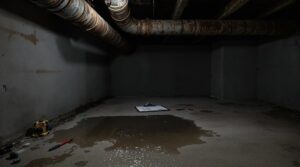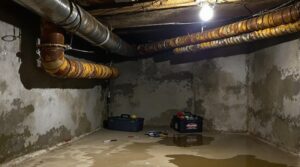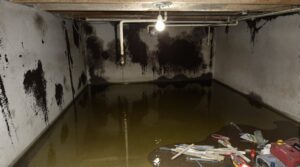Flood insurance typically covers damage resulting from storm surges, a type of coastal flooding caused by wind and atmospheric pressure changes during storms. National Flood Insurance Program (NFIP) policies provide storm surge coverage, usually up to $250,000 for residential buildings and $100,000 for personal property. However, policyholders should be aware of specific coverage limits and exclusions. Understanding these details is essential to guarantee adequate financial protection against storm surge losses. Further exploration can reveal more.
Key Takeaways
- Flood insurance typically covers storm surge damage, including flooding caused by tidal and surface waters.
- NFIP policies provide storm surge coverage, but limits and exclusions may vary depending on location and property type.
- Property owners should review policy terms for specific storm surge coverage limits, exclusions, and requirements.
- Supplemented coverage options, like excess flood insurance, can enhance financial protection and flood risk management.
- Familiarity with policy details, exclusions, and local building codes is crucial for effective storm surge preparedness and risk management.
Understanding Storm Surge and Its Impact
Because storm surges can have devastating consequences for coastal communities, understanding the phenomenon is essential for mitigating flood-related risks. A storm surge is a rise in sea level due to a combination of wind and atmospheric pressure changes during a storm, resulting in coastal flooding. The impact of storm surges can be severe, causing widespread damage to properties, infrastructure, and the environment. Coastal communities are particularly vulnerable to storm surges, which can lead to displacement of residents, loss of livelihoods, and significant economic losses. Understanding the dynamics of storm surges is vital for predicting and preparing for coastal flooding events, ultimately reducing the risk of damage and harm to communities. Effective risk management strategies can be developed by analyzing storm surge patterns and impacts.
What Is Typically Covered in a Flood Insurance Policy
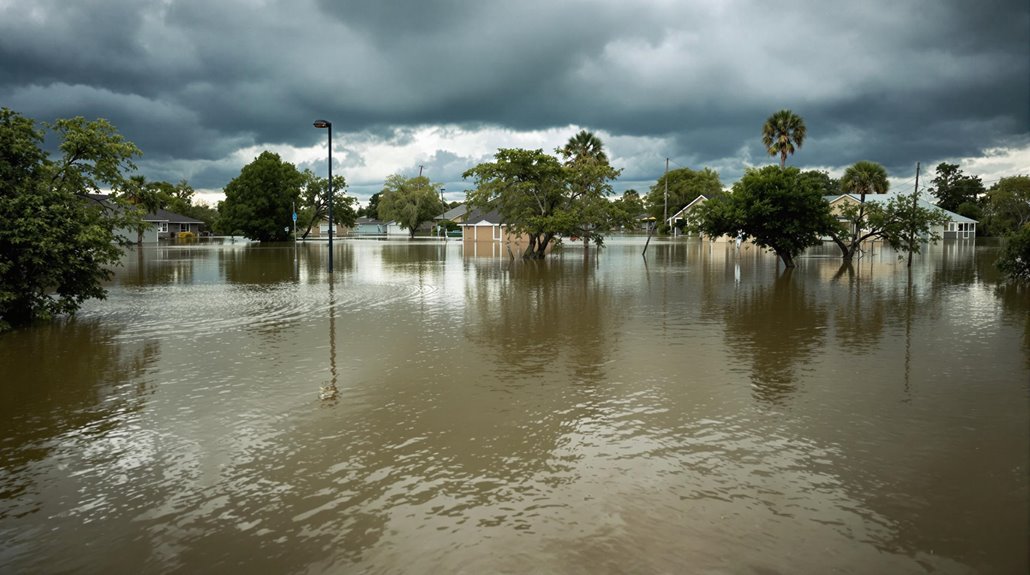
Flood insurance policies provide financial protection to policyholders against flood-related losses. Understanding flood insurance basics is essential for individuals and businesses in high-risk flood areas. A standard flood insurance policy typically covers physical damage to buildings and contents. This includes structural damage to the building and damage to personal property such as furniture and appliances. Coverage types vary depending on the policy, but most policies cover damage from overflow of inland or tidal waters and rapid accumulation of surface waters from any source. In addition to physical damage, flood insurance may also cover debris removal and loss avoidance measures. Policyholders should review their policy terms to understand specific coverage limits and exclusions. Coverage types and policy terms can impact the level of financial protection provided.
National Flood Insurance Program (NFIP) Coverage for Storm Surge

The National Flood Insurance Program (NFIP) provides storm surge coverage to policyholders, with coverage limits varying depending on the location and type of property. NFIP policies typically cover direct physical damage to buildings and personal property, including damage caused by storm surges, but it is essential to review policy details to understand specific coverage and exclusions. In the event of a storm surge, policyholders must follow the flood damage claim process to seek reimbursement for losses, which involves providing detailed documentation and proof of damage.
Storm Surge Coverage Limits
Regarding storm surge coverage limits under the National Flood Insurance Program (NFIP), numerous residential and commercial policyholders face limited financial protection against catastrophic losses resulting from severe coastal flooding. NFIP policies typically provide coverage up to $250,000 for residential buildings and $500,000 for commercial buildings, with personal property coverage capped at $100,000 for residential and $500,000 for commercial policies. These coverage limits pose insurance implications for policyholders, particularly those with high-value properties or assets in storm-prone areas. The coverage limitations may leave policyholders financially exposed to storm surge events, highlighting the importance of understanding NFIP's coverage limits and considering supplemental insurance options to mitigate potential losses. Storm surge events can result in costly damages.
NFIP Policy Coverage Details
Storm surge events and NFIP policy provisions intersect in complex ways, resulting in specific coverage details that policyholders must understand to manage their risk exposure effectively. NFIP policies provide flood insurance benefits for damage to buildings and personal property resulting from storm surges. However, coverage is subject to specific limits and deductibles. Policyholders must carefully review their policy documents to understand what is covered and what is excluded. To maintain continuous coverage, policyholders must also guarantee timely policy renewal. Failure to renew can result in a lapse in coverage, leaving the policyholder vulnerable to significant financial losses in the event of a storm surge. Understanding NFIP policy coverage details is essential for policyholders to mitigate their risk exposure and maximize their flood insurance benefits.
Flood Damage Claim Process
Following a storm surge event, policyholders with NFIP coverage must navigate the flood damage claim process to recover benefits for losses incurred. This process involves submitting a Notice of Loss to the NFIP within 60 days, providing detailed documentation of the damage, including photos, receipts, and contractor estimates. The NFIP will send an adjuster to assess the damage, determine the causality, and calculate the amount of the loss. Policyholders should familiarize themselves with flood claim procedures and insurance documentation requirements to facilitate a smooth claims process. This includes maintaining detailed records of property repairs, expenses, and correspondence with the NFIP. A thorough understanding of the claim process can help guarantee timely and fair payment for damages.
Private Flood Insurance Options for Storm Surge Coverage
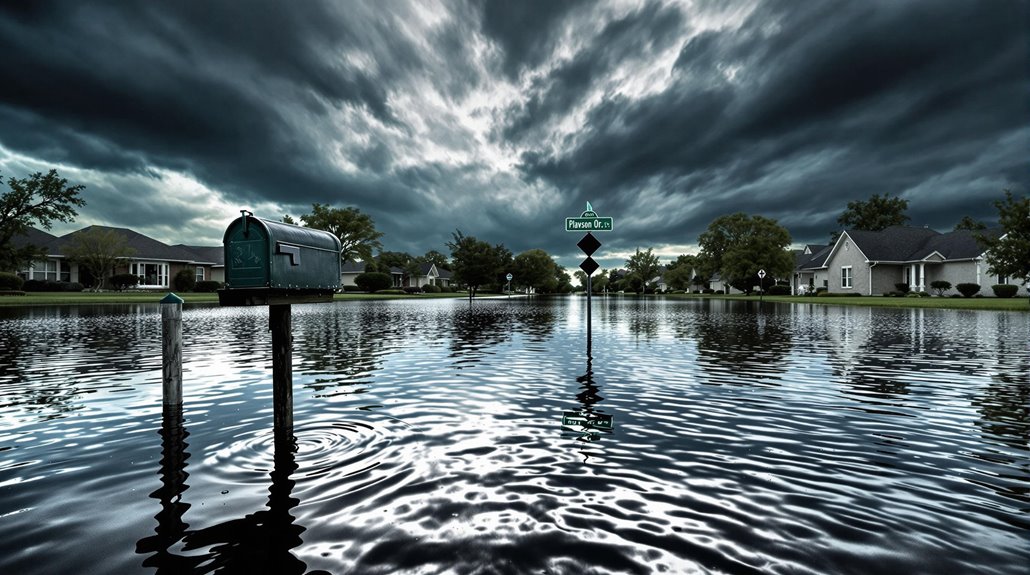
Numerous private insurance companies offer flood insurance options that include storm surge coverage, providing an alternative to the National Flood Insurance Program (NFIP). These private policy options often provide more extensive coverage and higher policy limits, which can be beneficial for homeowners and businesses in high-risk flood areas. Additionally, some private insurers offer supplemental coverage options, such as coverage for additional living expenses, debris removal, and sewer backup. Private flood insurance policies may also offer more flexible deductibles and payment plans, allowing policyholders to customize their coverage to meet their individual needs. By exploring private flood insurance options, individuals can guarantee they have adequate protection against storm surge and other flood-related risks.
Limitations and Exclusions of Flood Insurance Policies
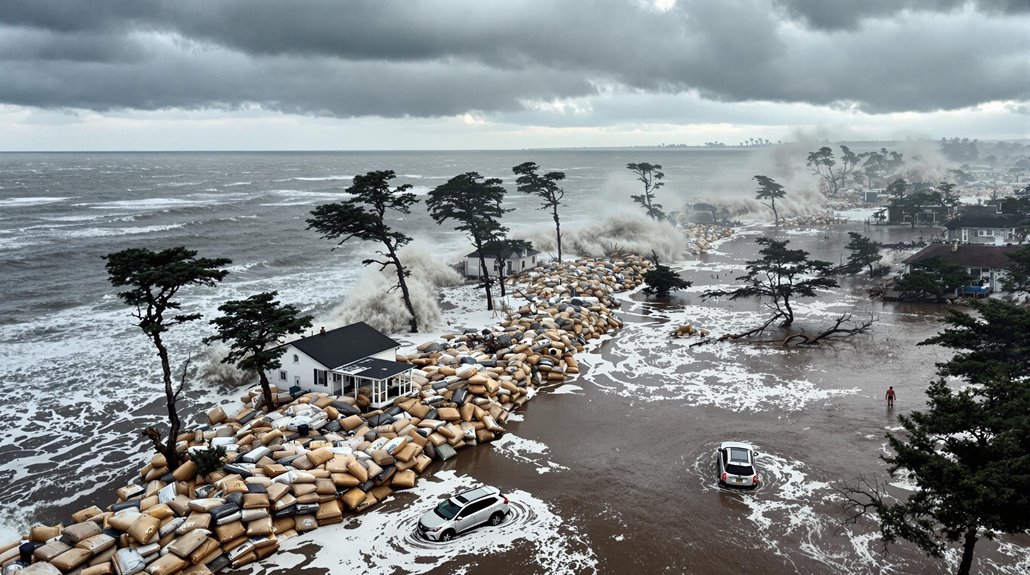
Flood insurance policies often contain specific coverage exclusions, such as damage to outdoor structures or landscaping, that policyholders should be aware of when selecting a policy. Excluded property types, including certain commercial or agricultural properties, may require specialized or surplus lines coverage. Understanding these limitations is crucial for individuals to assess their risk exposure and consider additional coverage options to guarantee adequate protection.
Policy Coverage Exclusions
While a flood insurance policy may provide financial protection against losses resulting from flooding events, it is vital to understand the policy's limitations and exclusions. Most flood insurance policies exclude coverage for damage resulting from mold, mildew, or moisture damage, unless directly caused by floodwaters. Additionally, losses resulting from earth movement, including landslides and sinkholes, are typically not covered. Coverage limitations also apply to areas below the lowest elevated floor of the building, such as basements or crawlspaces. Policy exclusions may also apply to specific building components, such as swimming pools and fences. Understanding these coverage limitations and policy exclusions is essential for policyholders to guarantee they are adequately protected against flood-related losses.
Excluded Property Types
In addition to policy coverage exclusions, policyholders must also be aware of excluded property types to fully comprehend the extent of their flood insurance coverage. Certain properties, such as those located in high-risk flood zones or with substantial prior flood damage, may be deemed uninsurable. Flood zone mapping plays a significant role in determining these exclusions. Additionally, properties with low property valuation or those not in compliance with local building codes may also be excluded from coverage. Understanding these exclusions is essential for policyholders to accurately assess their flood risk and potential financial losses. By recognizing excluded property types, individuals can take proactive measures to mitigate their flood risk and explore alternative risk management options. This knowledge enables policyholders to make informed decisions regarding their flood insurance coverage.
Additional Coverage Options
Several supplemental coverage options are available to help mitigate the financial impact of flooding events, providing a more extensive risk management strategy for policyholders. Standard flood insurance policies often have limitations and exclusions, highlighting the importance of exploring additional coverage options. Supplemental insurance can provide extended coverage for specific items, such as valuable possessions, or increased coverage limits for certain types of damage, such as sewer backup. Policyholders can also consider excess flood insurance, which provides coverage above the standard policy limits. By investing in additional coverage options, individuals can more thoroughly manage their flood risk and reduce the likelihood of incurring significant out-of-pocket expenses. This proactive approach can foster a sense of security and belonging among policyholders.
Steps to Take If You Live in a Storm Surge-Prone Area
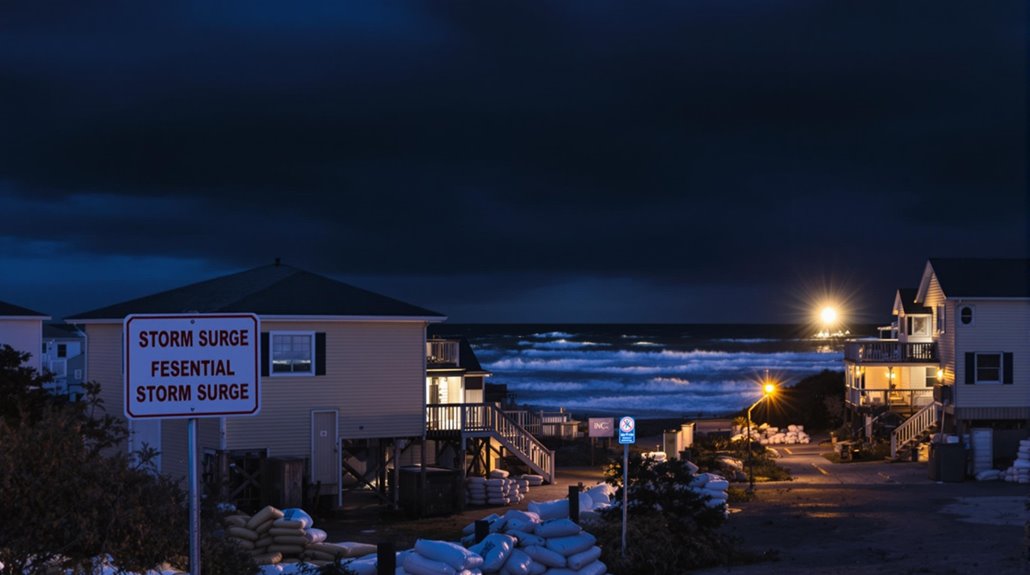
Residents of storm surge-prone areas face unique challenges in preparing for and responding to flood events, and consequently, they must take proactive steps to mitigate the risks associated with storm surges. To guarantee preparedness, residents can take the following steps:
| Storm Preparation Measure | Description |
|---|---|
| Create Evacuation Plans | Develop a plan to quickly evacuate the area in case of a storm surge warning. Identify safe zones and emergency shelters. |
| Elevate Electrical Outlets | Raise electrical outlets to at least 12 inches above the projected flood elevation to prevent water damage. |
| Install Storm Shutters | Install storm shutters to prevent wind-borne debris from causing damage to windows and doors. |
| Seal Walls and Floors | Seal walls and floors to prevent water infiltration. Apply a waterproof coating to walls and floors. |
| Stay Informed | Stay informed about weather conditions and storm surge warnings through local news and emergency alerts. |

